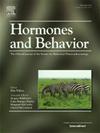Apelin-13 elicits lordosis behavior in female rats through the oxytocin/prostaglandin E2/GnRH signaling system
IF 2.5
3区 医学
Q2 BEHAVIORAL SCIENCES
引用次数: 0
Abstract
The present study investigated the role of the oxytocin (OT)/prostaglandin E2 (PGE2)/gonadotropin-releasing hormone (GnRH) and the progesterone receptor (PR) pathways in facilitating lordosis behavior induced by intrahypothalamic administration of 0.75 μg of apelin-13 in ovariectomized (OVX) rats primed with estradiol benzoate (EB). To explore this pathway, various inhibitors were administered bilaterally into the ventromedial hypothalamus (VMH) of EB-primed rats 30 min before the infusion of apelin-13. The inhibitors used included atosiban (ATO), an OT receptor antagonist; acetylsalicylic acid (aspirin), a cyclooxygenase-2 (COX-2) inhibitor; ONOAE3–208 (ONO), a PGE2 receptor antagonist; RU486, an antiprogestin for the PR; and antide, a GnRH-1 receptor antagonist. Apelin-13 at this dosage used, consistently induced lordosis at 30, 120, and 240 min post-infusion. The administration of atosiban, ONO, antide, and RU486, significantly reduced both the lordosis quotient (LQ) and lordosis reflex score (LS) at all assessed time points. In contrast, aspirin only decreased the LQ at 30 and 120 min, while the LS was reduced at all times tested. Because the OT/PGE2/GnRH pathway has been widely demonstrated in hypothalamic astrocytes as a regulator of GnRH release, it may also play a role in regulating female sexual behavior in estradiol-pretreated rats.
Apelin-13通过催产素/前列腺素E2/GnRH信号系统诱导雌性大鼠前凸行为
本研究探讨了催产素(OT)/前列腺素E2 (PGE2)/促性腺激素释放激素(GnRH)和孕激素受体(PR)通路在诱导去卵巢(OVX)大鼠下丘脑给药0.75 μg apelin-13诱导的前倾行为中的作用。为了探索这一途径,在注入apelin-13前30分钟,将各种抑制剂双侧注入eb -引物大鼠下丘脑腹内侧(VMH)。使用的抑制剂包括阿托西班(ATO),一种OT受体拮抗剂;乙酰水杨酸(阿司匹林),环氧化酶-2 (COX-2)抑制剂;ONOAE3-208 (ONO), PGE2受体拮抗剂;RU486,一种用于PR的抗黄体酮;和antide,一种GnRH-1受体拮抗剂。该剂量的Apelin-13在输注后30,120和240分钟持续诱导前倾。阿托西班、ONO、安替德和RU486在所有评估时间点均显著降低前凸商数(LQ)和前凸反射评分(LS)。相比之下,阿司匹林仅在30和120分钟时降低LQ,而LS在所有测试时间都降低。由于OT/PGE2/GnRH通路在下丘脑星形胶质细胞中作为GnRH释放的调节因子已被广泛证实,它也可能在雌二醇预处理大鼠的雌性性行为中发挥调节作用。
本文章由计算机程序翻译,如有差异,请以英文原文为准。
求助全文
约1分钟内获得全文
求助全文
来源期刊

Hormones and Behavior
医学-行为科学
CiteScore
6.70
自引率
8.60%
发文量
139
审稿时长
91 days
期刊介绍:
Hormones and Behavior publishes original research articles, reviews and special issues concerning hormone-brain-behavior relationships, broadly defined. The journal''s scope ranges from laboratory and field studies concerning neuroendocrine as well as endocrine mechanisms controlling the development or adult expression of behavior to studies concerning the environmental control and evolutionary significance of hormone-behavior relationships. The journal welcomes studies conducted on species ranging from invertebrates to mammals, including humans.
 求助内容:
求助内容: 应助结果提醒方式:
应助结果提醒方式:


